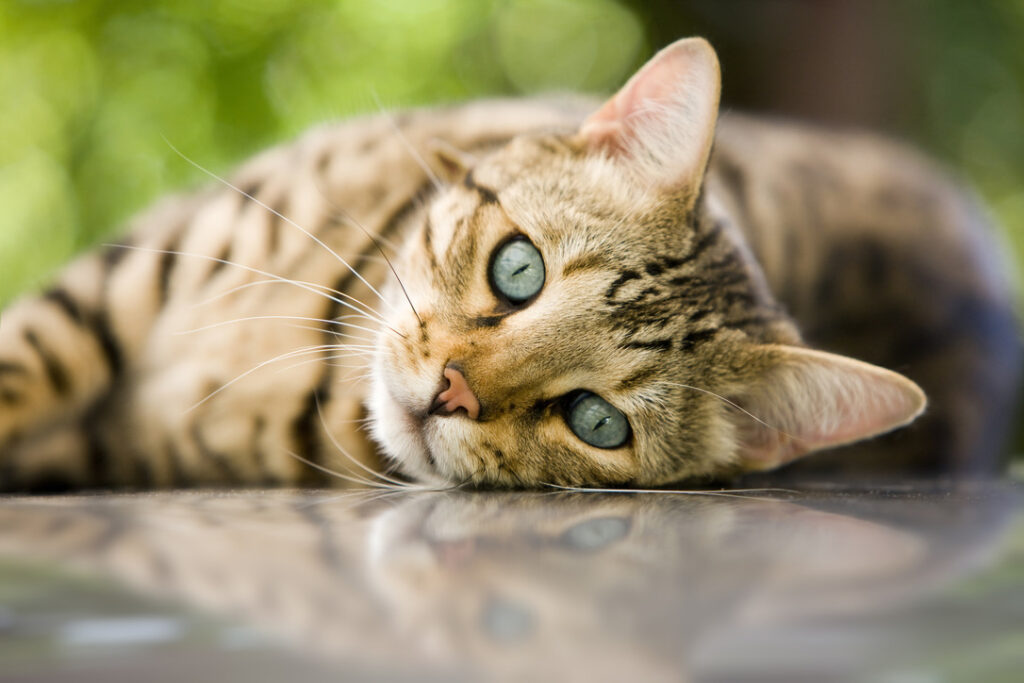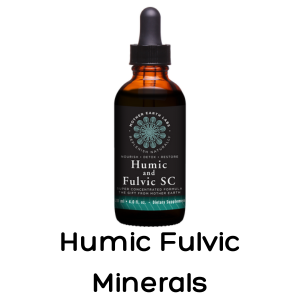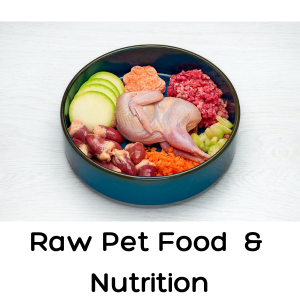What Is a Catio?
Think of a time you enjoyed relaxing on a patio. The clock didn’t exist. In a peaceful, comfy shelter under the sky, you felt protected as you looked out on the rest of the world. You can guess what a “catio” is, then. It’s an enclosed cat garden where your beloved pet can savor the best that life has to offer. In this post, we’re going to explain all the benefits of a catio and how to create a special one in your home.
By the way, at the end of this post is a glossary where you can look up any words in bold italics. One word you ought to learn right away is clowder which is what you call a group of cats.
Why Cats Need a Protected Enclosure
The key to a catio is appreciating all of the basic foundational feline needs.
To meet basic feline needs, you need to understand what drives them. Cats are predators. Most felines hunt alone but keep contact with other members of their species. They maintain individual territories by patrolling and tagging what’s theirs. Marking methods include urine spraying and clawing. They also leave scent trails from glands on their paw pads, cheeks, chins, and tail. To survive, they stay physically fit, alert, and healthy.
Exploration is a natural behavior that begins in early kittenhood. Their curiosity leads to learning that stimulates their active minds. Freedom of movement allows them to use their senses, express their instinctive drives, develop their mental health, and assert their independence. Autonomy in decision-making enables them to become skillful hunters.
Living in urban and suburban settings presents challenges such as busy roads, pollution, coyotes, hawks, unleashed dogs, aggressive humans, and more. Providing your pet with a protected enclosure prevents hazardous encounters while still offering access to the outdoors.
Cats Need a Physical Connection to Nature
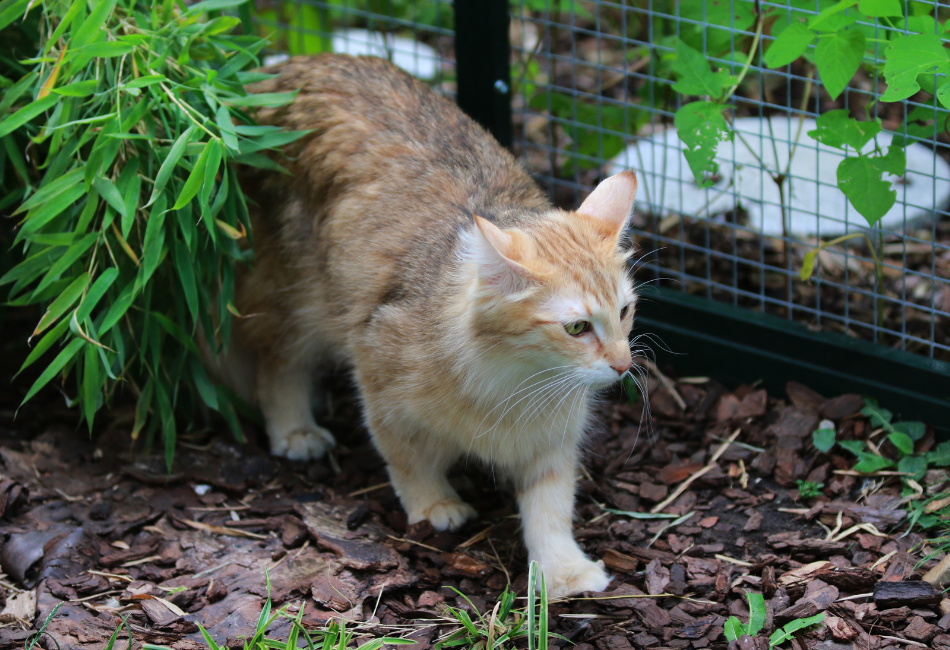
Nearly every living thing has developed to live outdoors and reap the many benefits.
Plants cleanse the air, offer cool shade and shelter, and provide sources of food as well as medicinal benefits. If you know anything about cats, you know how much they love to lurk in thickets of plants, nibbling the tips, spraying their calling cards on the leaves, and digging around the roots. In a moment we’ll share more information about creating an easy-to-maintain cat garden that your pet will love.
You may have heard about recent discoveries linking special bacteria in the gut to improved immune system function and digestive, cardiac, renal, and brain health. Similarly, it appears that exposure to certain bacteria — Mycobacterium vaccae — in ecologically balanced soil supplies multiple health advantages.
Because humans don’t have the acute sense of smell that cats, dogs, and other animals enjoy, we can’t appreciate the richness of outdoor air. Not only does wind dilute toxic gases but it blooms with oxygen. It likewise carries an abundance of scent molecules from miles around. Sniffing fresh air is so meaningful to your cat! It improves our pets’ health and mood. They feel safer because they’re updated on what’s out there. Cats who are prevented from exploring feel unbalanced and frustrated.
Next, we’re going to talk about sunbathing, fresh water, and places to loll about.
Sunbathing, Moving Water, and Loungy Spots
Why do we love what we love? Because basic needs are fulfilled. Cats love sunshine because they need it even though they have fur. Although they obtain most of their water from food, they still have an attraction to running water. Even though humans associate lying around with laziness, the truth is that all creatures require relaxation time to heal and grow. Let’s look at this in more detail.
The Value of Direct Sunlight
- Heat: Conserves energy and helps regulate body temperature.
- Vitamin D: Cats can’t manufacture vitamin D from sunlight on their skin the way humans do so they get most of the nutrient through their diet; however, the sun stimulates oil secretion in their skin; when cats groom their coats, the ingested oils contribute to vitamin D production during digestion.
- Sleep cycles: Sunlight generates melatonin, a hormone regulating the circadian rhythms that control sleep/wake cycles.
- Pain relief: Moderate heat from any source promotes healing by causing the local blood vessels to open; this in turn increases blood flow delivering oxygen, nutrients, and immune cells while carrying away waste products; ultraviolet light has antiseptic properties that slow or stop the growth of microorganisms such as bacteria, fungi, yeast, and yeast; heat and light also dry moist areas where such microorganisms flourish; unfortunately, window glass filters many of the beneficial wavelengths of sunlight — investing in a full-spectrum lamp can help everyone in the household.
- Antidepressant effect: Natural light triggers serotonin production bringing a wide range of positive effects on mood, appetite, memory, and sleep.
- Immune system support: Healers throughout human history have observed the curative powers of the sun; each of the elements listed above plays a part in strengthening the immune system.
Moving Water
Felines get most of their water from a biologically appropriate raw food diet (BARF) but the availability of clean water adds to their quality of life. Whether from fountains, small waterfalls, or dribbling faucets, most cats LOVE streaming, dripping, drizzling, rippling, frolicking water. They watch it, play with it, and eventually drink it. While they’ll appreciate a few stainless steel water bowls with heavy bases placed in sheltered spots, they’ll go over the moon if you gift them with a kitty fountain. In addition, since so many municipal water supplies are contaminated, buying an under-counter home water filtration system will ensure that your entire household has access to clean water free of microorganisms, toxins, heavy metals, microplastics, and other pollutants.
Loungy Spots
Do you really need an explanation about the physical and mental health benefits of a clean, comfy, tranquil place to relax? Such places aren’t luxuries — they’re necessities!
Natural Instincts: Bird Watching, Not Bird Catching
The ultimate in natural sensory stimulation ~ Bird Watching!!
- Sights
- Sounds
- Tastes
- Smells
- Tactile experiences: heat, cold, pressure, pain, vibration
Imagine how sunlight feels on your face … drops of rain … gusts of wind … the humidity and salty tang of ocean air … the scent and touch of grass on the soles of your bare feet … the magnificent feeling of strength you possess when you grip something with your hands …
Being natural predators, cats instinctively mobilize their senses to be ready to hunt. Their minds engage with their bodies to focus. Such activities enhance their problem-solving and decision-making skills. Plotting their method of approach and considering possible outcomes demands a lot of mental energy. They relish it. When you create an enclosed catio, you connect them with the wild world without endangering the local wildlife.
Decorating the Catio
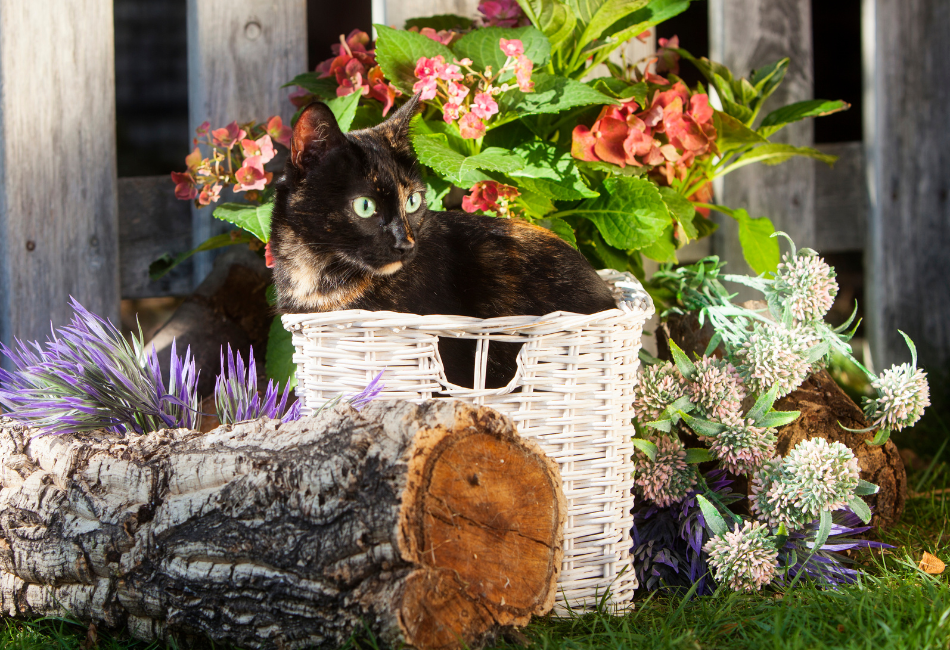
To decorate your feline paradise, you need input from your kitty. The features reflect cats’ basic needs, but the design must be user-friendly for you to effectively maintain it.
What Your Cat Needs
- Open areas for exercise and play
- Enough space for all inhabitants to claim their own little territories
- Patches of natural sunlight and shade
- Catwalks, thick branches, and perches
- Scratching posts and surfaces, both vertical and horizontal
- Sheltered areas and hidey-holes for privacy, beds, catboxes, and bowls
- Variety in the landscaping with tunnels and soft soil for lurking, prowling, spying, digging, and other cat-tivities
- Live plants in heavy containers with stable bases (read our Happy Tails post about cats and spider plants for ideas)
- Baskets and cardboard boxes
- Toys
- Although your kitty would probably love small objects to knock over, the behavior might worsen inside your home, so skip this idea
What You Need
Since you’re the groundskeeper, you need a nearby cabinet or closet to store supplies like paper towels, kitty litter, gardening tools, etc. Arrange the catio with pathways giving you access to every nook and cranny so you can get to bowls, fountains, catboxes, and bedding. Keep around a few stick-on lights as well as an extra flashlight. And you deserve a good place to sit and enjoy the fruits of your labor! The Garden of Eden indeed!
Mental Stimulation + Enrichment
All sentient beings require enrichment to stimulate their minds and allow them to succeed in their life calling. Some forms of enrichment are universal: opportunities to communicate with others of their own species and to explore variations in their environment. Other forms of enrichment are species-specific. How do you know if you’ve provided enrichment? If your pet shows curiosity, engages, and falls asleep afterward, then you’ve done a good job. Freedom to make choices is part of mental stimulation and enrichment. Destructiveness and hyperactivity are classic signs of boredom.
Best Plants For A Catio
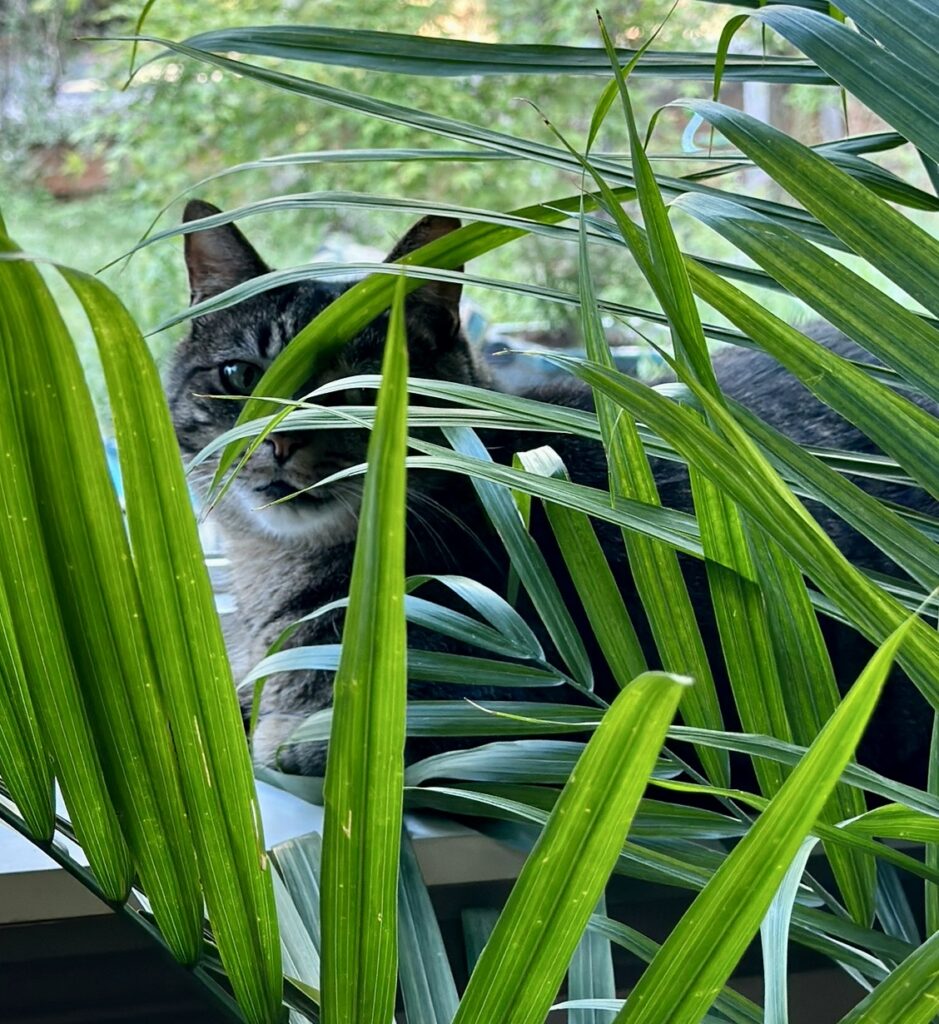
In the wild, cats utilize plants for many purposes: camouflage, shelter, food, natural medicine, shade, playgrounds, and marking posts to communicate their presence. It’s your choice whether you include annuals (plants that live for a one-year growing cycle), perennials (plants that grow larger year after year), or a combination. Here’s a partial list of cat-safe plants to put in the ground or in heavy containers with stable bases:
- Green plants: Boston ferns (improve air quality), carrot tops (nutritious), coleus, dracaena, hens and chicks (improve air quality), lettuces, ornamental cabbages, certain palms (areca, dwarf date, lady, reed — improve air quality), Norfolk Island pine, spider plants (improve air quality)
- Flowers: African daisies, asters, begonias, coneflowers, coral bells, cosmos, freesia, petunias, phlox, roses, snapdragons, sunflowers, violets
- Herbs and their blooms: Basil (improves air quality), bee balm, basil, cat thyme, chamomile, cilantro/coriander (improves air quality), dill (improves air quality), lavender, lemon balm (improves air quality), lovage, oregano, parsley, peppermint, rosemary (improves air quality), sage (improves air quality); (all nutritious with different medicinal properties)
- Sprouts: Alfalfa, beans, broccoli, clover, grasses, radishes, sunflowers; (all nutritious with fiber, protein, vitamins, and minerals)
- Grasses: Alfalfa, bamboo (improves air quality), barley, Bermuda, fescue, Kentucky bluegrass, lemongrass, oat, rye, and wheatgrass; (all grasses contain fiber, vitamins, and possibly help clean the teeth, throat, and intestines as well as help purge worms; the texture and scent are pleasing to many cats)
Can cats eat wheatgrass since many of them find it irresistible? Yes! Not only does it contain fiber, protein, and several vitamins and minerals, but also chlorophyll and antioxidants. Most feline dietary experts believe that grasses help cats vomit up hairballs, feathers, and other indigestible intestine-clogging matter. “Yukkk!” you say. Although all cat-friendly grasses aid in these processes, wheatgrass is especially beneficial. If something contributes to your kitty’s physical and emotional wellbeing, you want it in your catio.
Avoid using any unsafe chemicals such as pesticides and weed killers on the plants and in the soil. Cats have sensitivities to many substances that don’t bother dogs, so check out organic ways to keep the catio plants healthy. Our Happy Tails article on ferns further discusses plants for your feline buddies.
DIY Catio Plans
It’s always wise to consult with reliable experts with experience. Whether you hire a builder or DIY (do it yourself), your cat will thank you for a well-thought-out catio. For inspiration, check out this video. In fact, since Catio Spaces is one of our affiliates, get 10% off by using our Promo Code:
TipsForHappyTails50
Basic Principles Of Ideal Environments:
Some key principles apply to all sentient beings. They need territory to call their own with room to exercise. They need space to interact with others as well as have privacy from others. Critters also need proper food and water. Whether they live in the air, water, on the ground, or underground, their habitat needs frequent refreshing. Finally, they all need species-specific mental enrichment.
Dogs
Our Happy Tails post on Siberian huskies offers a wealth of information on ideal dog habitats. Don’t forget that different breeds have different needs.
Small Pets such as Rabbits, Ferrets, Hamsters, and Rats
Little critters love to burrow, bury, move, inspect, and chew things. They’re not destructive by nature, but they have continuously growing teeth that they have to grind down. Most little critters need a buddy or two. No matter how much you play with them, they crave the company of their own species.
Birds
If you love birds, read our Happy Tails post on cockatiels. Most birds are very social beings with complex body language and vocalizations. They also need to fly just as a horse or donkey needs to run, so they need lots of air space. Lots of bird lovers set aside an entire room so their birds can fly free.
Reptiles and Amphibians
Although their minds aren’t like ours, reptiles and amphibians won’t thrive without a clean habitat with hidey-holes and places to climb. Some are social and prefer a buddy but not in tight quarters. Because they can’t regulate their body temperatures as easily as mammals and birds, they always need the means to warm up or cool down.
Fish
Fish species vary considerably. People underestimate their intelligence. Some, like bettas, prefer a large territory with running water and lots of surface plants. Crowding drives them to fight for more territory. Goldfish are very social but grow quickly so they need large tanks with frequent water changes. Since fish breathe water, maintaining the right chemistry in their tanks determines life or death. Some fish need gravel, some need leaves, and all can benefit from live plants.
Arthropods such as Scorpions and Spiders
People have been arguing for years whether or not arthropods have sentience. Are they aware of themselves? Do they feel pain? Are they capable of learning? Some people contend that there are degrees of sentience. Err on the side of compassion — humans too often deny the intelligence and emotions of even their own species.
Glossary
Aerosol: A suspension of tiny living or inorganic particles in a gaseous medium such as air.
Antiseptic: Preventing the growth and spread of disease-causing microscopic organisms.
Arthropod: A member of the phylum Arthropoda, characterized by segmented bodies, external skeletons, and the absence of a central backbone; they may be aquatic or terrestrial; examples include insects, spiders, crabs, scorpions, and centipedes.
Circadian rhythms: Organisms’ biological clocks that respond to light and dark, affecting sleep/wake cycles, digestion, hormone release, body temperature, and other functions.
Clowder: A group of cats.
Conservatory: A living space for relaxation or study attached to the home and filled with plants and sunshine.
Enrichment: Stimulation, opportunities to generate thought, new learning, new positive experiences.
Particulates: Small particles of organic and inorganic materials.
Sentience: Self-awareness in relation to the environment as well as the past and future.
Terrestrial: Relating to the Earth’s land surface as opposed to underground, underwater, or in the air.
The Last Word
Curiosity doesn’t kill cats. In fact, cats with nine lives have survived by taking advantage of safe havens like catios. The history of Eden, Heaven, and Terrestrial Paradise reveals that the concept has mattered to civilizations around the world for thousands of years. Being a cat lover, you agree that being home with your beloved kitty is heavenly. Whether in shade or sun, a daybed or futon in your conservatory garden will transform your shared space into a catio fit for a god or goddess. Or a clowder of gods and goddesses.
Resources to Discover More
Best practices of progressive zoos to simulate the natural environment of wild animals in confinement:
https://www.aza.org/animal-care-manuals
Special soil bacteria you’ll be hearing more about:
https://en.wikipedia.org/wiki/Mycobacterium_vaccae
Some facts about cat psychology:
https://medium.com/moments-of-passion/the-psychology-of-cats-b86b41bca3b0
ASPCA list of plants toxic and non-toxic to cats:
www.aspca.org/pet-care/animal-poison-control/toxic-and-non-toxic-plants?field_non_toxicity_value[]=02

